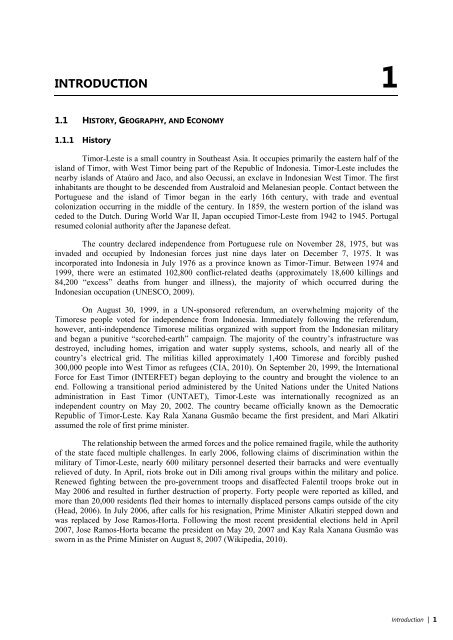Demographic and Health Survey 2009-10 - Timor-Leste Ministry of ...
Demographic and Health Survey 2009-10 - Timor-Leste Ministry of ...
Demographic and Health Survey 2009-10 - Timor-Leste Ministry of ...
Create successful ePaper yourself
Turn your PDF publications into a flip-book with our unique Google optimized e-Paper software.
INTRODUCTION 1<br />
1.1 HISTORY, GEOGRAPHY, AND ECONOMY<br />
1.1.1 History<br />
<strong>Timor</strong>-<strong>Leste</strong> is a small country in Southeast Asia. It occupies primarily the eastern half <strong>of</strong> the<br />
isl<strong>and</strong> <strong>of</strong> <strong>Timor</strong>, with West <strong>Timor</strong> being part <strong>of</strong> the Republic <strong>of</strong> Indonesia. <strong>Timor</strong>-<strong>Leste</strong> includes the<br />
nearby isl<strong>and</strong>s <strong>of</strong> Ataúro <strong>and</strong> Jaco, <strong>and</strong> also Oecussi, an exclave in Indonesian West <strong>Timor</strong>. The first<br />
inhabitants are thought to be descended from Australoid <strong>and</strong> Melanesian people. Contact between the<br />
Portuguese <strong>and</strong> the isl<strong>and</strong> <strong>of</strong> <strong>Timor</strong> began in the early 16th century, with trade <strong>and</strong> eventual<br />
colonization occurring in the middle <strong>of</strong> the century. In 1859, the western portion <strong>of</strong> the isl<strong>and</strong> was<br />
ceded to the Dutch. During World War II, Japan occupied <strong>Timor</strong>-<strong>Leste</strong> from 1942 to 1945. Portugal<br />
resumed colonial authority after the Japanese defeat.<br />
The country declared independence from Portuguese rule on November 28, 1975, but was<br />
invaded <strong>and</strong> occupied by Indonesian forces just nine days later on December 7, 1975. It was<br />
incorporated into Indonesia in July 1976 as a province known as <strong>Timor</strong>-Timur. Between 1974 <strong>and</strong><br />
1999, there were an estimated <strong>10</strong>2,800 conflict-related deaths (approximately 18,600 killings <strong>and</strong><br />
84,200 “excess” deaths from hunger <strong>and</strong> illness), the majority <strong>of</strong> which occurred during the<br />
Indonesian occupation (UNESCO, <strong>2009</strong>).<br />
On August 30, 1999, in a UN-sponsored referendum, an overwhelming majority <strong>of</strong> the<br />
<strong>Timor</strong>ese people voted for independence from Indonesia. Immediately following the referendum,<br />
however, anti-independence <strong>Timor</strong>ese militias organized with support from the Indonesian military<br />
<strong>and</strong> began a punitive “scorched-earth” campaign. The majority <strong>of</strong> the country’s infrastructure was<br />
destroyed, including homes, irrigation <strong>and</strong> water supply systems, schools, <strong>and</strong> nearly all <strong>of</strong> the<br />
country’s electrical grid. The militias killed approximately 1,400 <strong>Timor</strong>ese <strong>and</strong> forcibly pushed<br />
300,000 people into West <strong>Timor</strong> as refugees (CIA, 20<strong>10</strong>). On September 20, 1999, the International<br />
Force for East <strong>Timor</strong> (INTERFET) began deploying to the country <strong>and</strong> brought the violence to an<br />
end. Following a transitional period administered by the United Nations under the United Nations<br />
administration in East <strong>Timor</strong> (UNTAET), <strong>Timor</strong>-<strong>Leste</strong> was internationally recognized as an<br />
independent country on May 20, 2002. The country became <strong>of</strong>ficially known as the Democratic<br />
Republic <strong>of</strong> <strong>Timor</strong>-<strong>Leste</strong>. Kay Rala Xanana Gusmão became the first president, <strong>and</strong> Mari Alkatiri<br />
assumed the role <strong>of</strong> first prime minister.<br />
The relationship between the armed forces <strong>and</strong> the police remained fragile, while the authority<br />
<strong>of</strong> the state faced multiple challenges. In early 2006, following claims <strong>of</strong> discrimination within the<br />
military <strong>of</strong> <strong>Timor</strong>-<strong>Leste</strong>, nearly 600 military personnel deserted their barracks <strong>and</strong> were eventually<br />
relieved <strong>of</strong> duty. In April, riots broke out in Dili among rival groups within the military <strong>and</strong> police.<br />
Renewed fighting between the pro-government troops <strong>and</strong> disaffected Falentil troops broke out in<br />
May 2006 <strong>and</strong> resulted in further destruction <strong>of</strong> property. Forty people were reported as killed, <strong>and</strong><br />
more than 20,000 residents fled their homes to internally displaced persons camps outside <strong>of</strong> the city<br />
(Head, 2006). In July 2006, after calls for his resignation, Prime Minister Alkatiri stepped down <strong>and</strong><br />
was replaced by Jose Ramos-Horta. Following the most recent presidential elections held in April<br />
2007, Jose Ramos-Horta became the president on May 20, 2007 <strong>and</strong> Kay Rala Xanana Gusmão was<br />
sworn in as the Prime Minister on August 8, 2007 (Wikipedia, 20<strong>10</strong>).<br />
Introduction | 1
















